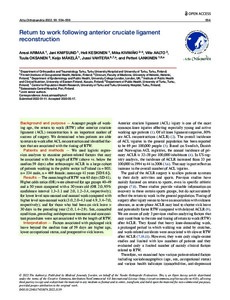Return to work following anterior cruciate ligament reconstruction
Knifsund Jani; Keskinen Heli; Mäkelä Keijo; Lankinen Petteri; Kivimäki Mika; Aalto Ville; Oksanen Tuula; Arimaa Anssi; Vahtera Jussi
https://urn.fi/URN:NBN:fi-fe2022102463210
Tiivistelmä
Background and purpose - Amongst people of working age, the return to work (RTW) after anterior cruciate ligament (ACL) reconstruction is an important marker of success of surgery. We determined when patients are able to return to work after ACL reconstruction and identified factors that are associated with the timing of RTW.
Patients and methods - We used logistic regression analyses to examine patient-related factors that may be associated with the length of RTW (above vs. below the median 59 days) after arthroscopic ACLR in a large cohort of patients working in the public sector in Finland (n = 803; n = 334 male, n = 469 female; mean age 41 years [SD 8.6]).
Results - The mean length of RTW was 65 days (SD 41). Higher odds ratios (OR) were observed for age groups 40-49 and >= 50 years compared with <= 30 years old (OR 2.0, 95% confidence interval 1.3-3.1 and 2.0, 1.2-3.4, respectively); for lower level non-manual and manual work compared with higher level non-manual work (3.0, 2.0-4.3 and 4.9, 3.4-7.0, respectively); and for those who had been on sick leave > 30 days in the preceding year (2.0, 1.4-2.9). Sex, comorbid conditions, preceding antidepressant treatment and concomitant procedures were not associated with the length of RTW.
Interpretation - Factors associated with prolonged sick leave beyond the median time of 59 days are higher age, lower occupational status, and preoperative sick leaves.
Kokoelmat
- Rinnakkaistallenteet [27094]
